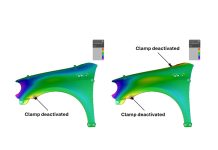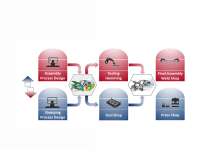We had the honor to be selected as the computer simulation partner for a recent Auto/Steel Partnership (A/SP) study that considered the feasibility of using higher strength and advanced high-strength steels to achieve weight reductions of hemmed closure panels: project #AS-8004. One of the A/SP mandates is to research, develop, and promote steel applications to achieve the fuel economy goals of the North American Auto industry, rather than the use of materials like aluminum or carbon fiber.
| Outer material | Inner material | |
| Supplier A | BH-280 0.55mm− Bake hardenable grade 280 | DC04 0.7 mm |
| Supplier B | BH-440 0.55mm− Bake hardenable grade 440 | DC04 0.7 mm |
| Supplier C | DP-490 0.50mm− Dual-phase grade 490 | DC04 0.7mm |
While advanced high-strength steels, or AHSS, are used extensively in the body-in-white, applications for the exterior “Class-A” panels have been limited to mild steel and some dent-resistant classes of material (~210 MPa yield strength). For this project, the steel-making partners provided three developmental materials of higher yield strengths to see if parts produced from these grades could, in fact, achieve panels of acceptable quality.

A/SP project geometry was created to emulate problematic geometry from real closure panels
A set of forming and flanging tools were designed and built by A/SP contributor Superior Cam, and simulations were performed using AutoForm-HemPlannerplus R6. Each outer part underwent a series of forming operations — a shallow forming operation and a flanging operation — to deliver the pre-hemmed part geometry.

Thinning of initial flanged outer panel
The initial forming of the parts was performed for each material, and the results showed that the panels were safe although they exhibited formability concerns in the stretch flanges at tight inside corners, much like what is expected for similarly shaped parts features. The inner panels were very safe as result of minimal deformation from shallow shape.

Springback trend for the flanged outer panel before hemming
Springback review of the initial stamped parts with the different materials resulted in springback deviation between 2-5 mm from net shape for the outers and 1-3 mm for the inners. However, no compensation was applied to either shape in order to maintain same net shape for all the different materials.

Hemming tools and roller hemming robot, image courtesy of AS/P and Superior CAM
Because the study wanted to validate the performance of the computer simulation on the hemming process as well as any strain history of the sheet metal as result of the initial forming and flanging process, it was decided to use the AdvancedHemming method of AutoForm. Both the outer and inner panels were imported with complete forming history — thinning and thickening, strains and stresses, and springback deformation — prior to the hemming operation. This enabled the project partners to evaluate the outer and the inner springback effects as an assembly.
QuickHemming, by contrast, would have enabled the project partners to run earlier feasibility of the hemming process, but without requiring the setup and simulation of the initial forming operations of the inner and outer panels. QuickHemming is a tool for design evaluation of the proposed part prior to the engineering of the full tooling processes of inner and outer parts. However, since the dies were built as a proof tool, the output from the QuickHemming, such as early predicted failure of parts without full strain history, was not needed. In a real vehicle program, a failure prediction during QuickHemming analysis would indicate to product and process engineers that hemming geometry was not feasible, and that it would be wise to initiate part and hemming process changes before costly investment in engineering of the stamping process.
Additionally, because the materials in the study were specialized materials developed by steelmakers, it was essential that the simulations capture the true performance of the materials. For this reason, the materials suppliers provided AutoForm with the raw tensile test data from the actual test lots of material used in the study. AutoForm engineers used the test data to build “material cards” that represented directly the mechanical behavior of the tested sheet metal instead of using “typical” values for constitutive parameters. To assume input values based on minimum, typical, or nominal n-value, tensile strengths, R-values, and FLC would not be truly representative of the behavior of these specific developmental high-strength steels.

3-step roller hemming process use 3 passes of cylindrical rollers to complete hem
The defined hemming process was a roll hemming operation with three consecutive passes of cylindrical rollers. The process was described using imported part geometry—the hemmed part geometry, pre-hemmed flanged part geometry, and inner part shape—along with key parametric inputs into AutoForm-HemPlannerplus. With this basic definition, the tools and tool paths generate automatically. Each part was planned to start with an initial hemming pass to roll the flanged shape to 50 degrees from net shape, followed by a roller pass intended for 30 degrees from net shape, and a final roller pass to close the hem to the inner part net shape.
After hemming, the areas that showed high thinning after initial flanging increased in severity. This is common for similar geometries, was expected, and observed in the test die. The springback trends were very similar for each of the materials tested. Other hemming quality metrics, such as hem thickness, roll-in, and creepage were also very similar from material to material. Because the part designed for this study is a fair representation of some of the most challenging areas on real closure panels, the study participants are confident that the conclusions of the trial will hold up well if these materials were applied to production intent parts.

Thinning in the critical areas of the hemmed flange matched expectations from trials
The target of this project is twofold:
- Prove that advance high-strength steels can be formed and hemmed without additional complexity
- Validate reliability of simulation software predictions

Hemming Quality Metrics
AutoForm simulation reliably predicted the hemmed benchmark products:
- Creepage, roll-in, and hem height are reported
- Springback of the assembled panel can be analyzed
- Surface defects can be assessed after hemming

Simulation allowed for evaluation of other hem quality metrics like roll-in, hemming deviation, and hem thickness
In conclusion, the study participants were satisfied that the engineering and simulation tools employed provided reasonable results during product feasibility and process engineering. The physical trials results and confirmed that the simulated results of a hemming process with AutoForm-HemPlannerplus are reliable predictions. If any of their organizations were required to supply advanced high-strength steel for use as outer closure panels that needed hemming, they are confident that the simulation results would be accurate predictions of the behavior of their materials in the forming and hemming processes.

Springback of the assemblies matched expectations
AutoForm-HemPlannerplus provides valuable feedback on the validity of proposed combinations of stamping sheet metal grades and product shapes for outer closure panels. The inclusion of the full forming history for the AdvancedHemming method ensures that final validation of hemmed closure panels will be accurate and reliable. The QuickHemming method would enable material supplier applications engineers and OEM product designers to recognize limitations of their designs long before release of styling and closure product designs, preventing the loss of lead time while pursuing stamping process engineering designs that are not feasible.














“it was essential that the simulations capture the true performance of the materials” – personally, I think it is one the most difficult and important issues. Good job.
Claire,
thank you very much for your feedback!